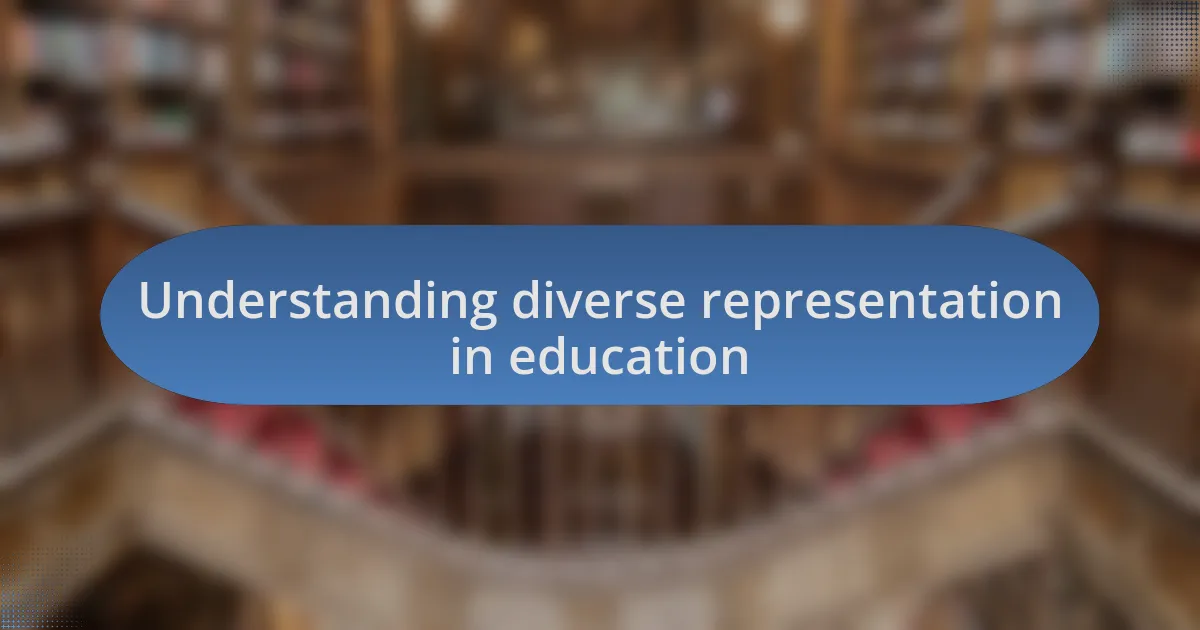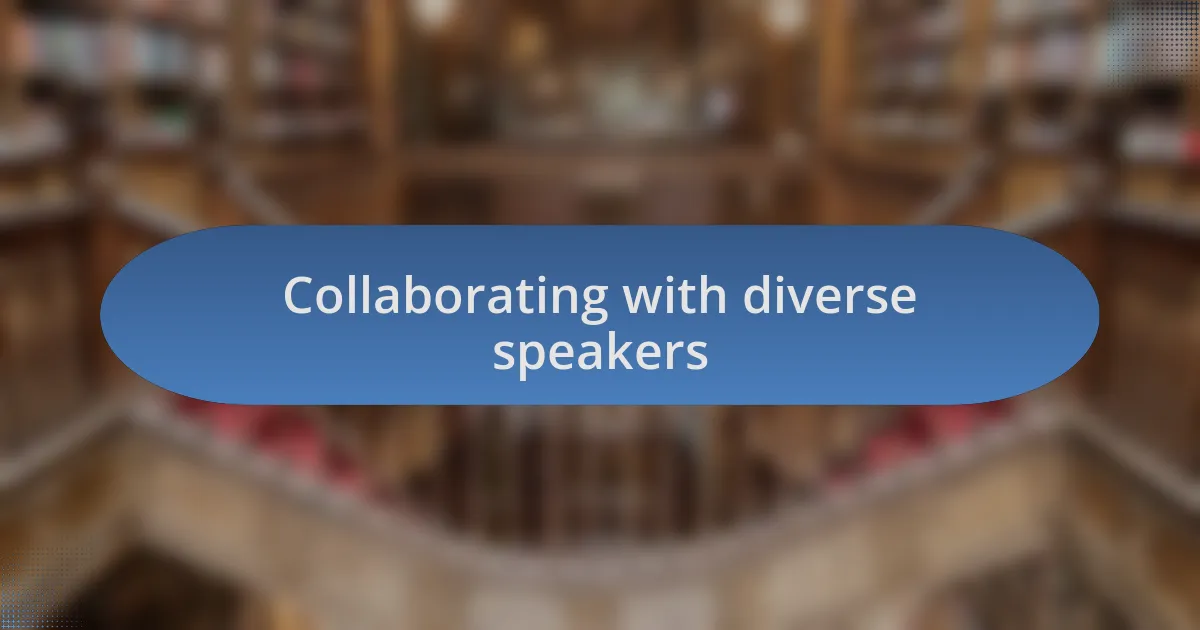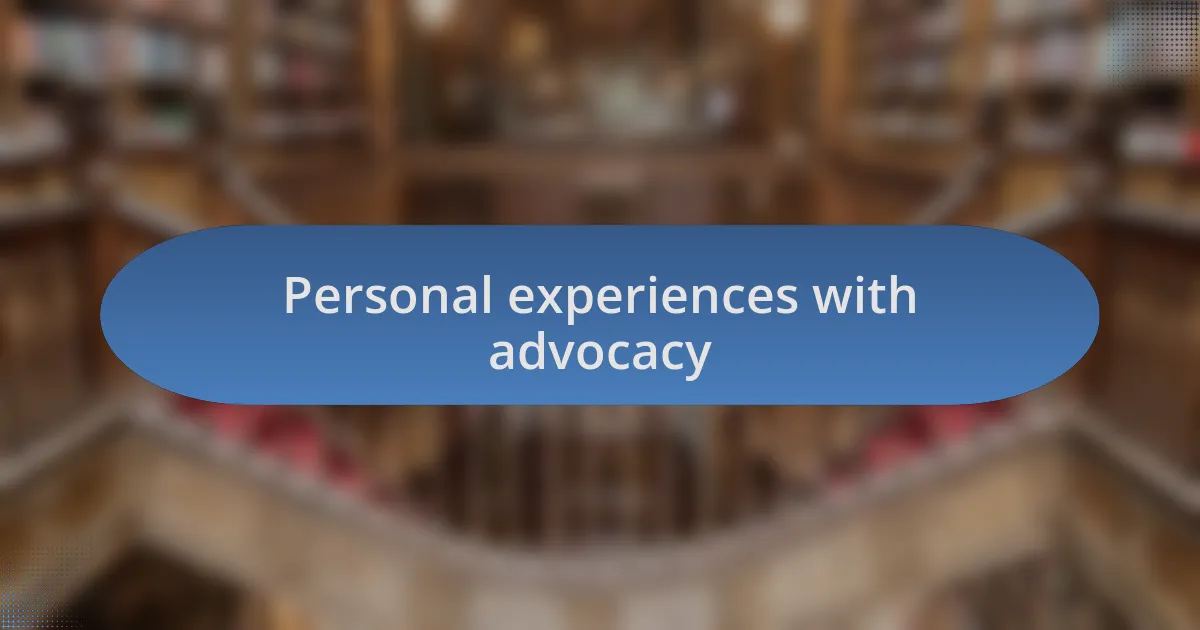Key takeaways:
- Diverse representation in education enriches discussions and fosters critical thinking and empathy among students.
- Involving a diverse planning committee and engaging with the community are crucial for organizing inclusive events.
- Collaborating with diverse speakers transforms narratives and encourages deeper discussions, impacting audience perceptions.
- Creating accessible materials enhances engagement and inclusivity, catering to varied learning preferences and communication styles.

Understanding diverse representation in education
Diverse representation in education is about more than just checking boxes; it’s about creating an environment where all voices are heard and valued. I recall a time when I attended a workshop where the speaker, a member of an underrepresented group, shared their unique journey. It struck me how their perspective not only enriched the discussion but also created an immediate connection with the audience, proving that everyone’s experience contributes to the educational tapestry.
When I think about the impact of diverse representation, I often ask myself: how can students truly thrive if they don’t see themselves reflected in the curriculum? One time, I volunteered at a school where a curriculum was being developed. It was eye-opening to witness how including authors and historical figures from various backgrounds transformed classroom discussions, making them more engaging and relatable for students.
Moreover, embracing diverse representation fosters critical thinking and empathy among all students. I remember a class discussion in which a student shared their cultural background while discussing literature. This not only opened up dialogue but also prompted others to reflect on their own experiences. Isn’t it powerful to think about how these interactions can shape future generations?

Strategies for organizing inclusive events
One effective strategy for organizing inclusive events is to actively involve a diverse planning committee. In my own experience, having team members from different backgrounds not only broadened our perspectives but also helped us identify potential blind spots. I remember a conference where the committee included voices from various communities, leading us to choose topics that resonated with a wider audience. It’s fascinating how a variety of viewpoints can shape the agenda and ensure that everyone feels represented.
Another crucial aspect is to engage with the community you want to serve before the event. During a recent seminar I helped organize, we reached out to local organizations that support underrepresented groups. This collaboration uncovered valuable insights about what the community deemed important. It made me wonder: how often are we truly listening to the needs of those we aim to engage? The feedback we received led to a significant increase in attendance and participation, demonstrating the power of dialogue.
Additionally, creating accessible spaces is paramount. I once attended an event held in a venue that wasn’t equipped for individuals with disabilities. The discomfort of those attendees was palpable, and it highlighted for me how important it is to consider physical accessibility as part of inclusivity. By ensuring that the location is welcoming to everyone, we can foster an environment where everyone can engage freely. Isn’t it essential to think about how every small detail impacts the overall experience of attending an event?

Collaborating with diverse speakers
Collaborating with diverse speakers can fundamentally transform the narrative of any educational event. I recall a workshop where we invited speakers from various cultural backgrounds, each sharing their unique experiences and knowledge. The authenticity in their voices was palpable, and attendees were not just passive listeners; they were engaged and inspired. It really made me think: how often do we miss out on enriching conversations simply by not diversifying our speaker lineup?
Moreover, creating an environment that celebrates diverse perspectives encourages deeper discussions. In one event, a speaker from an underrepresented community shared a poignant story that resonated with many attendees, including myself. Witnessing the connections formed in that space reminded me of the importance of representation. It begs the question: how much more powerful can our messages be when they reflect the diversity of our audience?
Additionally, I find that working with diverse speakers challenges preconceived notions within the audience. For instance, a panel I organized with speakers from various professional fields sparked unexpected dialogues about intersectionality. Participants left with not only new knowledge but also a shifted mindset. Isn’t it fascinating that the inclusion of varied voices does more than inform — it builds bridges between communities?

Creating accessible event materials
Creating accessible event materials starts with understanding the diverse needs of your audience. When I organized a recent workshop, I made it a point to provide materials in various formats, including large print and digital copies. Not everyone absorbs information in the same way, and I remember how grateful some attendees were for options that suited their specific learning preferences.
I also believe that incorporating visuals, like infographics or video summaries, can make a world of difference. At one event, we shared a short video overview which allowed attendees who might struggle with dense texts to engage more comfortably. It was a reminder that accessibility isn’t just about meeting minimum standards; it’s about inviting everyone into the conversation. Have you ever noticed how a well-designed graphic can communicate complex ideas more clearly than words alone?
Moreover, simple language can often be overlooked but is equally crucial. I recall feedback from a participant who appreciated our effort to avoid jargon in our materials. It struck me that even small adjustments in language can create a more inclusive atmosphere. Isn’t it empowering to consider that when we prioritize accessibility, we genuinely enhance the learning experience for all?

Personal experiences with advocacy
When I first stepped into the world of advocacy, I attended an event where a panel focused on cultural diversity in education. I was deeply moved by the stories shared by speakers who represented historically marginalized groups. It made me realize how vital it is to amplify these voices and address the systemic barriers they face. Have you ever felt the energy in a room filled with people sharing their truths? It’s electric and reaffirming.
In my own organizing efforts, I once worked with a group of college students from various backgrounds to brainstorm ideas for a community event. One participant, who was often quiet, expressed how hesitant they were to speak up because they felt their perspective was underrepresented. Listening to them made me rethink how I approached group discussions. Have you ever noticed how just one voice can shift the dynamics of a conversation? It was a powerful reminder of our responsibility to create spaces where everyone feels valued.
I also recall a particularly impactful moment when I collaborated with a local nonprofit to host a workshop tailored for underserved communities. The hesitance and reluctance of potential participants were palpable, stemming from various past experiences. It was a challenge to address their skepticism and ensure that they felt welcome. How do we build trust in these situations? For me, the key was consistent follow-up and showing genuine interest in their stories. It taught me that advocacy is not a one-time event but an ongoing dialogue that requires patience and understanding.